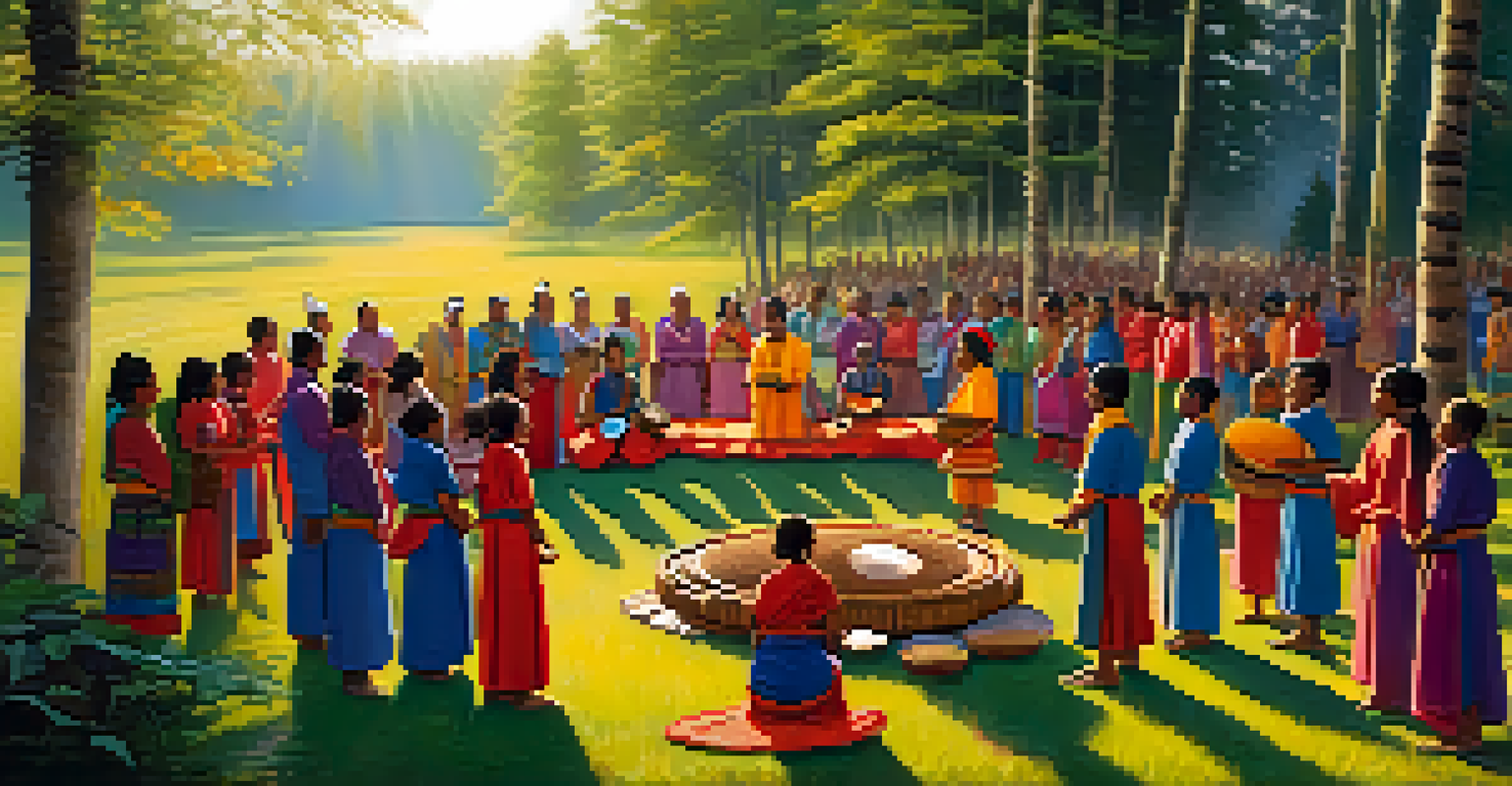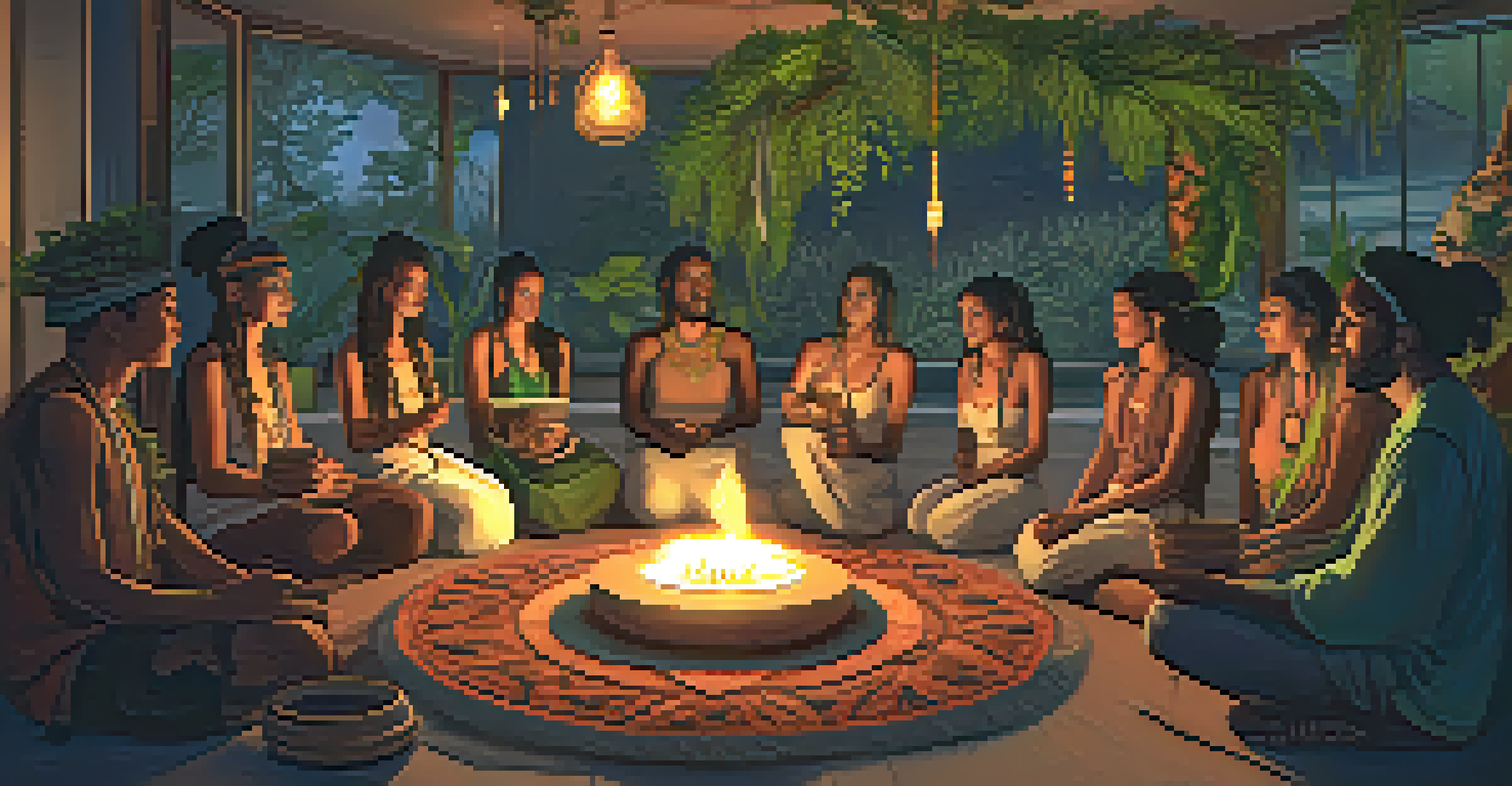Cultural Variations: Music Styles in Different Ayahuasca Traditions

Understanding Ayahuasca and Its Cultural Roots
Ayahuasca is a powerful plant medicine traditionally used in South American shamanic practices. Its roots are deeply embedded in the cultures of the Amazon, particularly among indigenous tribes like the Shipibo and Ashaninka. These communities view Ayahuasca not just as a healing tool, but as a gateway to spiritual realms, often accompanied by unique musical traditions.
Music is the shorthand of emotion.
The music played during Ayahuasca ceremonies, known as Icaros, serves multiple purposes. It guides participants through their experiences, evokes emotional responses, and connects them with the spiritual essence of the plants involved. Each culture has its own distinct style and interpretation of Icaros, reflecting their unique beliefs and practices.
Understanding the cultural context of Ayahuasca helps us appreciate how music enhances the ceremonial experience. As we dive deeper into various traditions, we will uncover the rich tapestry of musical styles that accompany this sacred ritual.
The Shipibo Tradition: Melodies of the Amazon
The Shipibo people, renowned for their intricate textile designs, also have a vibrant musical tradition that complements their Ayahuasca ceremonies. Their Icaros often feature repetitive melodic patterns, creating a hypnotic effect that aids in the participants' journeys. The music is typically accompanied by traditional instruments like flutes and drums, fostering a deep connection to the natural environment.

In Shipibo ceremonies, shamans sing Icaros that are believed to carry the spirit of the plants and ancestors. These melodies are often improvised, allowing the shaman to respond to the energy and needs of the participants in real-time. This dynamic interaction between music and the ceremony can lead to profound healing experiences.
Cultural Roots of Ayahuasca Music
Ayahuasca music, particularly Icaros, is deeply intertwined with the cultural practices of indigenous communities like the Shipibo and Ashaninka, enhancing the ceremonial experience.
Moreover, the Shipibo tradition emphasizes the importance of intention in music-making. Each Icaro is infused with specific intentions, whether it's to heal, protect, or guide participants through their visions, highlighting the powerful role of music in spiritual practices.
The Ashaninka Tradition: Rhythms of Connection
The Ashaninka community, located in the central Amazon, brings a distinctive flavor to the Ayahuasca experience through their musical styles. Their Icaros are often characterized by a lively, rhythmic quality, incorporating clapping and call-and-response patterns that engage participants actively. This interactive approach creates a sense of community and connection during the ceremony.
The essence of music is in its ability to connect us to our emotions and to one another.
In Ashaninka ceremonies, music serves as a bridge between the physical and spiritual worlds. The rhythms and melodies are thought to resonate with the energies of the participants, guiding them through their individual experiences. The communal aspect of music strengthens the bonds among participants, fostering a supportive environment for healing.
Additionally, Ashaninka musicians often draw inspiration from their surroundings, using nature as a source of creativity. This deep connection to the land is reflected in their songs, which celebrate the beauty of the Amazon and the wisdom of their ancestors, further enriching the ceremonial experience.
Peruvian Urban Traditions: A Modern Fusion
In recent years, Ayahuasca ceremonies have spread beyond indigenous communities into urban settings, leading to the emergence of new musical styles. Urban shamans often blend traditional Icaros with contemporary genres like folk, rock, or even electronic music, creating a unique fusion that resonates with a broader audience. This evolution demonstrates the adaptability of Ayahuasca traditions in a modern context.
These urban ceremonies often attract diverse participants from around the world, each bringing their own musical influences and expectations. As a result, the music played in these settings can vary widely, incorporating various instruments and styles to create a more eclectic experience. This blending of cultures can lead to a rich tapestry of sounds that enhances the Ayahuasca journey.
Modern Fusion in Urban Ceremonies
Urban Ayahuasca ceremonies are blending traditional music with contemporary genres, creating a unique and eclectic experience while raising questions about cultural appropriation.
However, this fusion also raises questions about cultural appropriation and the authenticity of the experience. It's essential for urban shamans to honor the roots of the tradition while finding ways to make it relevant for contemporary audiences, ensuring that the spirit of Ayahuasca remains intact.
The Role of Music in Healing and Transformation
Music plays a vital role in the healing aspect of Ayahuasca ceremonies, acting as a catalyst for emotional release and spiritual insight. The right melody can evoke deep feelings, helping participants confront traumas and blockages that may surface during their journeys. This transformative power of music is one of the reasons it is considered an essential component of the ritual.
During the ceremony, participants often report experiencing heightened emotions in response to specific Icaros. These melodies can create a safe space for vulnerability, allowing individuals to explore their inner worlds and uncover hidden truths. In this way, music becomes a tool for self-discovery and healing.
Furthermore, the communal aspect of music enhances the healing process. When participants join in singing or clapping along, they create a collective energy that amplifies the experience, fostering a sense of unity and shared purpose. This connection can be profoundly healing, as it reinforces the idea that no one is alone on their journey.
Cultural Appropriation and Ethical Considerations
As Ayahuasca ceremonies gain popularity globally, the discussion around cultural appropriation has become increasingly relevant. Many individuals are drawn to the spiritual experiences offered by Ayahuasca, yet it's crucial to approach these traditions with respect and understanding. This involves recognizing the cultural significance of music and ensuring that it is not exploited or misrepresented.
Ethical considerations come into play when urban shamans incorporate traditional Icaros into their practices. It's important for them to acknowledge the origins of the music and give credit to the indigenous cultures that have maintained these traditions for centuries. This respect for the source not only honors the lineage but also enriches the overall experience for participants.
Music's Role in Healing Journeys
Music serves as a catalyst for emotional release and spiritual insight during Ayahuasca ceremonies, fostering a communal energy that amplifies healing experiences.
Engaging in open dialogues about cultural sensitivity and appropriation helps create a more inclusive environment within the Ayahuasca community. By fostering understanding and respect, we can ensure that the beauty of these musical traditions continues to thrive while honoring their roots.
The Future of Music in Ayahuasca Ceremonies
As we look ahead, the future of music in Ayahuasca ceremonies is likely to evolve even further. With the increasing globalization of spiritual practices, new influences will continue to shape the sounds accompanying these sacred rituals. This evolution presents both opportunities and challenges for preserving the integrity of traditional music while embracing new styles.
Emerging artists and shamans are experimenting with innovative sounds and techniques, seeking to create transformative experiences for participants. The incorporation of modern technology, such as sound healing instruments and digital compositions, may also play a role in the evolution of ceremonial music. However, it's essential to maintain a balance between innovation and tradition.

Ultimately, the future of music in Ayahuasca ceremonies will rely on the collective efforts of those who honor the roots of the tradition while exploring new avenues of expression. By fostering a spirit of collaboration and respect, we can ensure that the musical legacy of Ayahuasca continues to resonate across cultures and generations.